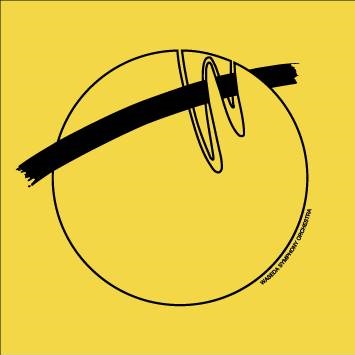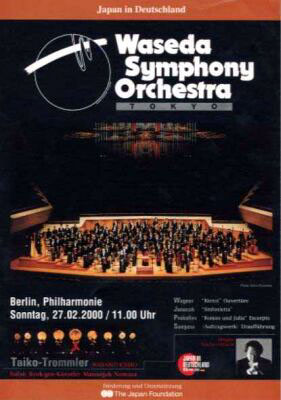■About Performance
We believe that by sharing the joy of music, we can have a deeper relationship with all people, transcending cultural and linguistic differences. Based on this belief, we have been studying every day with the motto of “better music, more beautiful music”. The past eight overseas concert tours have been organized according to the same policy. This has led to the experience of the stage and the audience working together to create a single piece of music in halls around the world, and it seems to be deeply engraved in the hearts of not only the performers but also the audience. Our activities have been highly evaluated by people in various fields, including diplomatic missions abroad and Japan companies, as contributing to international understanding. This may be possible because we are students who can transcend all interests. It is a great honor for me to be able to play such a role as a student with the help of all of you.
Leading up to the realization of the 2000 German Concert Tour, successive members of the orchestra have made various efforts. His first overseas concert trip was to participate in the 5th International Youth Orchestra Competition (commonly known as the Karajan Competition) organized by the Karajan Foundation in Berlin in 1978, and to travel to Germany and Austria. In this competition, our orchestra won first place despite being the only student who did not specialize in music among all the participating organizations and received the Karajan Gold Medal. It was this success that led us to start our international concert tour.
The following year, in 1979, we were invited to the Evian Music Festival in France as the winner of the Karajan Competition, and at the same time we conducted a “performance tour between France and Switzerland”. In 1982, the music management of the Federal Republic of Germany (at that time) was invited to perform in 15 cities for one month, as the first long-term concert tour.
In 1986, the band expanded its scale to include the “1986 European Concert Tour,” which lasted for 43 days in 20 cities in five countries: France, East and West Germany, Austria, and Czechoslovakia. During this tour, I had the opportunity to perform live recordings by Deutsche Grammophon and TV recordings by the Berlin Philharmonic (SFB).
Through these ambitious activities, the name of the orchestra spread even further, and the “1989 World Tour” was realized, starting with a performance in the Philippines as a cultural ambassador of Japan in December 1988, and a total of 22 performances in 10 countries, including Japan, France, East and West Germany (at that time), the Netherlands, Austria, Switzerland, the United Kingdom, and the United States.
In addition, the “1992 World Concert Tour” featured performances in 16 cities in seven countries: Germany, which achieved the unification of East and West, Switzerland, Austria, Spain, Portugal, the United States, and Japan.
Three years later, on the 1995 World Tour, we asked Hiroyuki Iwaki, the conductor laureate of the orchestra, to accompany us and performed in 18 cities in four countries, including Germany, Austria, the United States, and Japan.
In commemoration of the 20th anniversary of winning the Karajan Competition, we performed Verdi’s opera “The Force of Fate” overture and Stravinsky’s ballet music “The Rite of Spring” in 18 cities in seven countries: the Philippines, Malaysia, Singapore, Spain, Germany, the United States, and Japan.
“Such a large orchestra has overcome all the demands of music” (Berlin Morgenpost), and “There is no parallel to the Waseda Orchestra!” (Boston Globe), “The sound of the orchestra throughout was deeply moving” (New York Times Illustration). Through these activities, the name “Waseda Symphony” has spread all over the world, and people are eagerly awaiting the return of Waseda performances in various places.
In planning the “2000 Germany Concert Tour,” which will be the ninth overseas concert tour in total, we received an invitation from the Ministry of Foreign Affairs to participate in the “Year of Japan in Germany.” The purpose of this “Japan Year in Germany” was to introduce and promote the exchange of Japan culture, mainly in the former East German region, which had not had many connections with Japan.
For this project, the Ministry of Foreign Affairs commissioned Mr. Shigeaki Mieda to compose a new work, which was taken up as the main program of each park. Mr. Mieda is one of the most prolific composers in Japan today, and in this work, he attempted to fuse the Japanese drum, an instrument that represents Japan culture, with the orchestra, which is a Western culture. In this work, I also had the pleasure of co-starring with people who are active in the world of Japanese drumming.
The orchestra’s concert tours have been held almost once every three years. According to this tradition, the next concert trip would have been planned in 2001, but since 1997, we have received an enthusiastic invitation from the Embassy of Japan in Bonn, and the plan has been moved up by one year. We would like to express our deepest gratitude for the invitation to such a significant event and hope that this concert tour will contribute to cultural exchange between our two countries.
The late Mr. Herbert von Karajan has taken a deep interest in our orchestra since the Karajan Competition, and has given us full support by giving us various advice and handwritten messages. He believed that “music” could contribute to peace, and that exchange and understanding between the younger generations would be a bridge to peace, and he actively paved the way for the orchestra to such overseas concert tours.
“Orchestral music is the flower of Western culture, and the flowers that have taken root in the East return to their hometowns, bloom with large flowers, and then drop their seeds. And it will sprout new buds.”
This is a critique of the orchestra that appeared in a prominent German newspaper. This is the purpose of our performance tours, and we strongly believe that the path to world peace is for people to understand and communicate with each other across borders through the joy of music.
■Concert Overview
- Mid-February.2000~Mid-March.2000
■Conductors
- Yoichiro Omachi
■Program
- Richard Wagner/Overture to Rienzi
- Händel/Harp Concerto in B frat major
- Janáček/Sinfonietta
- Prokofiev/Romeo and Juliet
- Sigeaki Saegusa/Concerto for Taiko and Orcestra
| Place | Concert Hall |
|---|---|
| ◇Germany | |
| Rostock | Nikoleikirche |
| Hoyerzwerda | Lausitzhalle |
| Chemnitz | Stadthalle gr.Saal |
| Dresden | Kulturpalast |
| Bielefeld | Rudolf-Oetker-Halle |
| Halle | Georg-Friendrich-Handel-Halle |
| Lutherstadt Wittenberg | Philharmonie |
| Berlin | Philharmonie |
■Performance period
- Mid-February.2000~Mid-March.2000
■Conductors
- Omachi Yoichiro
■Program
- Richard Wagner / Overture to Rienzi
- Händel / Harp Concerto in B frat major
- Janáček / Sinfonietta
- Prokofiev / Romeo and Juliet
- Sigeaki Saegusa / Concerto for Taiko and Orcestra


